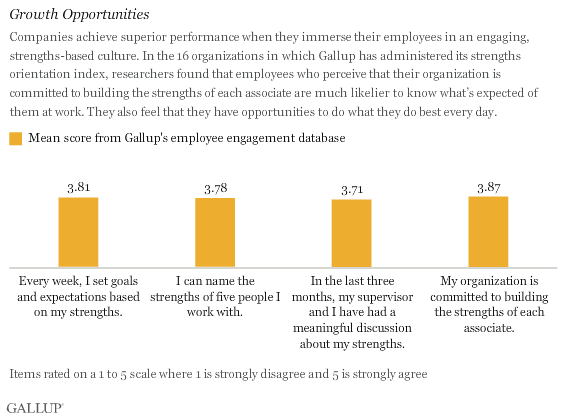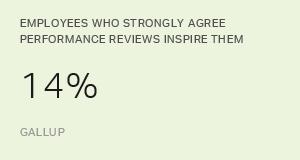Many organizations have found that strengths-based employee development can lead to an engaged and productive workforce. These organizations begin their strengths-based initiatives by helping employees identify their strengths. Then managers help employees align their strengths to the responsibilities and expectations of their roles.
The prevailing attitudes of a workplace affect the success of a strengths-based development initiative.
Great managers know how to do this instinctively. But it's no easy feat, and organizations usually have a wide variation in management talent. The prevailing attitudes of a given workplace also affect the success of a strengths-based employee development initiative: Teams that encourage and support these efforts can reap substantial rewards, while teams that take a hands-off approach can expect much less success.
But what are the key components that determine whether a strengths-based development initiative will succeed? And what can managers and employees do to ensure that their workgroup -- and their organization -- can benefit and improve performance?
Four essential components
To identify the components of a successful program and learn how great managers maximize strengths to drive business performance, Gallup researchers conducted onsite observations and interviews with employees and managers who used a strengths-based approach to employee development. They found wide variation at the workgroup level in how well employees applied what they learned about their strengths as well as a wide range of support for applying strengths in an organizational setting. Nevertheless, clear patterns that set the most successful workgroups apart began to emerge.
Armed with this knowledge, Gallup developed a short assessment to evaluate the components of a strengths-based development program. Gallup then tested it with Company A, a large business that has invested in effective employee engagement programs for more than 10 years.
After Company A's employees took the short assessment, Gallup determined that four components explained much of the range in sales and operating income among Company A's 606 business units and were essential to a successful strengths-based development program:
-
Employees became aware of their strengths and their colleagues' strengths.
-
Employees began to experience success through more intentional application of those strengths.
-
Employees perceived shared commitment to the strengths philosophy among coworkers and managers.
-
Employees perceived shared commitment to the strengths philosophy from company leadership.
Assessing interventions
Next, Gallup developed a short battery of items to assess employee perceptions of how receptive their work environment was to a strengths intervention and how employees used strengths in their work. These items are:
- Every week, I set goals and expectations based on my strengths.
- I can name the strengths of five people I work with.
- In the last three months, my supervisor and I have had a meaningful discussion about my strengths.
- My organization is committed to building the strengths of each associate.
Since their initial development, the index items have been administered to employees in 16 organizations, usually alongside the organizations' Q12 employee engagement assessment. Gallup's analysis of the resulting data shows that employees who perceive that their organization is committed to building the strengths of each associate are much likelier to know what's expected of them at work. That, in turn, makes them feel like they have the opportunity to do what they do best every day, that the mission or purpose of their company makes them feel their job is important, that their opinions count, and that someone at work cares about them.
These employees also perceive greater opportunities to learn and grow, that they have support in their developmental efforts, and that they are receiving feedback on how they are doing. The means scores below suggest that these organizations have room to grow and that additional strengths development efforts could result in increased organizational performance.

When Gallup tested these items with samples of the U.S. working population, we discovered that only 3% of employees could strongly agree with all four items. Such a low rate of agreement reinforces that there are ample opportunities for organizations to improve by implementing strengths-based development initiatives. Our research shows that companies achieve superior performance when they deeply involve their employees in an engaging, strengths-based culture.
If organizations monitor and track the four components of a successful strengths program, they will see improvements in their performance. An employee who feels that someone at work cares about him, who feels a sense of progress, and who is encouraged to make the most of his unique personality for the benefit of the company usually pays back that attention many times over. If he thinks his employer takes an active interest in him personally, he is much likelier to repay the company with the work ethic, enthusiasm, and commitment it wants from him. In short, if employees perceive that their organization supports them and is committed to them, they are more likely to have feelings of obligation to the employer that enhance organizational performance.
